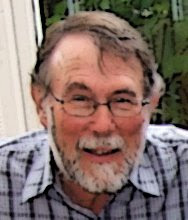We spent four nights and five days walking the coast, but rather than an "and then we went to this place" sort of post I thought I'd concentrate on the scenery and the aboriginal history this time.
Full Day 1 took us along the rockiest part of the coast to the Interview River. (I'd love to know the origin of that name: did Abel Janzoon Tasman grill each of his crew members before deciding who was going to swim ashore with the Dutch flag?) The coast here is a succession of little rocky bays and headlands, all being dashed by the Southern Ocean, and remember, the potential fetch for the waves extends all the way to Argentina! The rocks are of various types, but except for the places where granite reaches the shore they are savagely rough. Being shipwrecked on this coast doesn't bear thinking about.
Days 2 & 3 took us along vast sandy beaches; vast both in length and depth. With the spray coming in from the breakers it was often impossible to see the far end of the beach, and on this very exposed coast the wind and storm waves have created a huge strandline, backed by enormous dunes. The dunes are very mobile, so they are constantly engulfing the bush at one end and exposing old soil surfaces at the other as they creep across the landscape.
A series of rivers and streams flow to the sea, or at least the larger ones do. Some are completely blocked by the dunes to form lakes, while others just manage to break through the sand. We only had to get our boots off to cross a couple (the Interview and Lagoon Rivers) but neither reached above the knee.
Our passage along the beaches was slow; not only because of the soft sand in places, but also because I was hoping to survey the beaches for Hooded Plovers, a little shorebird that is under serious pressure on most Australian beaches since it nests just above the high water mark. Tasmanian beaches, and especially these remote ones, are an important refuge. So we were scanning the top of the beach as we walked, but fortunately soon discovered that the birds seemed to concentrate around the streams. In the end we saw over 30 birds, and that was probably an underestimate, since some were singles and probably had a mate sitting on eggs somewhere nearby. Other significant birds included a large flock of Red-necked Stints and a number of Ruddy Turnstones on the rocky reefs. Both of these birds breed in Siberia and fly to Australia for their summer holidays.
But it seemed all the time that we were walking on a haunted coast. If a group of slim dark figures had appeared from the bush we would hardly have been surprised, since the evidence of aboriginal occupation is all around and plain to see. The Tarkiner people from this part of Tasmania were probably more sedentary than other tribes since the local food supply from land and sea was so abundant that they did not need to make seasonal migrations. Most obvious traces are the huge piles of shells ("middens") that make it easy to believe that they were here for more than forty thousand years: periwinkles, abalone and many other shellfish, with smaller amounts of bone. They used stone tools and scrapers, hand axes, flakes and the stones from which they were chipped litter the ground; picking them up gives you a feeling of connection for a moment, but all these relics must be left where they are found. It's sad that not everyone respects these traces; vehicle tracks right through middens are quite common.
We saw several hut depressions: hollows in the dunes that were once roofed over and lined to accommodate an extended family hearth group. The tragedy is that we know so little about these people. They were all gone before the mid-1800s and no one bothered to find out much about how they lived or what was important to their culture. As I was walking along I was struck by the thought that they would have looked on this wild landscape with complete familiarity, knowing where to go and what to do for all their needs, while we must carry all our tents, our clothing, our food, cooking stoves.......... and the satellite phone.
As we neared Sandy Cape the influence of the more recent inhabitants of this coast became more and more obvious (though we had followed 4WD tracks almost all the way from the Pieman). But that's another story........
Highlights from John's Gospel
1 week ago



























